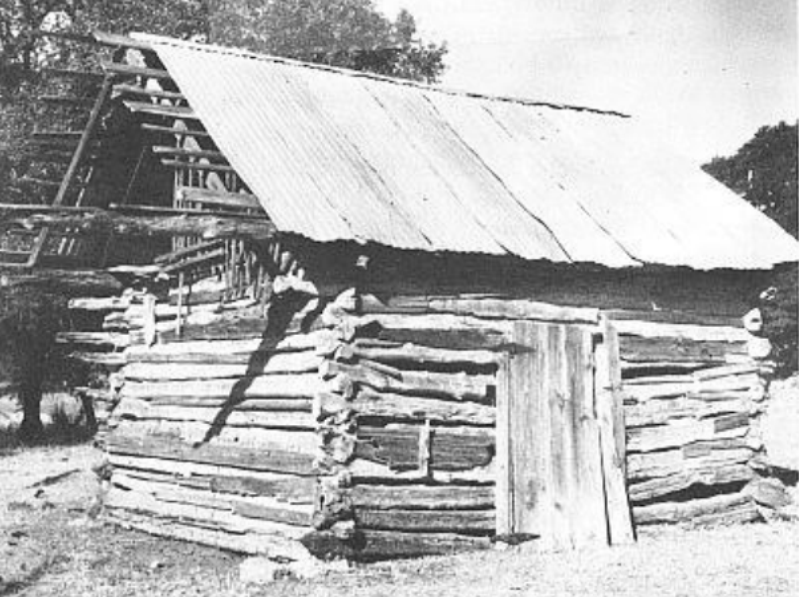
Pictured is Zephyr’s first school
The careless days of summer freedom are coming to an end for students, and the opportunities and difficulties of a new school year are about to begin. To be honest, it’s always something I have mixed feelings about. In the old days, kids weren’t stuck inside for endless hours. They at least had a walk or a ride on horseback to and from the place. You could stop at the creek, feel the wind of the first cold front blowing in, or pick flowers on the way. There was more of a family atmosphere, as the older schools were simply groups of families working together to educate their children.
In the early days of Brown County, as they are now, local schools were an integral and nearly essential installation, as they gave not only educational opportunities to isolated families, but also a network of friends and acquaintances that I’m sure was very valuable to kids who might otherwise have been quite alone on ranches and outside small settlements. In his chronicle of early Brown County history called The Promised Land, James White states that it is likely that the first school in the settled areas of the county formed in Thrifty during the 1870s.
“It is claimed that the first regular school in Brown County was conducted at Thrifty by Henry Sackett, who later was a representative of this district in the legislature. Early settlers in this and other communities had much difficulty arranging school facilities, usually solving the problem by “pooling’ the children of two or three families with a part-time tutor in charge. School work was begun in Brownwood at a very early day before the town site was moved across Pecan Bayou to the Greenleaf Fisk tract, present downtown district of the city,” White wrote. According to the Brown County Museum of history, the first public school system came early in Brownwood, established in 1876 with a state allotment per child of a little over 4 dollars.
Zephyr had a school in operation in 1876. The school was built on a piece of land donated by J.W. Braddock, and was a one room log cabin structure located near where the cemetery is today. The cabin schoolhouse had a dirt floor and log benches for seating. Taught by the Reverend T.A. Ish, it had 15 students enrolled in that year, and they paid $1.50 a month for the privilege.
Brownwood area writer Robert E Howard, the famous originator of Conan the Barbarian, had a few harsh things to say about school. Robert is quoted in the book Blood and Thunder, the Life and Art of Robert E. Howard, as having written, “I hated school. I hate the memory of school. It wasn’t the work I minded; I had no trouble with the tripe they dished out in the way of lessons–except arithmetic and I might have learned that if I’d gone through the trouble of studying it. I wasn’t at the head of my classes–except in history–but I wasn’t at the foot either. I generally did just enough work to keep from flunking the courses, and I don’t regret loafing as I did. But what I hated was the confinement–the clock-like regularity of everything; the regulation of my speech and actions; most of all the idea that someone considered himself or herself in authority over me, with the right to question my actions and interfere with my thoughts.”
I can empathize with Howard’s thoughts on school because I hated it myself. I remember watching the clock through the long afternoons of endless droning by the math teachers, trying to use my mind to scoot the hands along faster, watching the light move with agonizing slowness across the blinds. While many kids thrive at school, quite a few suffer from the same sense of boredom and restriction that afflicted Howard. They have my sympathy.
I doubt if the good Reverend Ish had to check clear backpacks in case a student started randomly shooting the others. Actually many students in those days carried their own guns to school and there were designated places for them to leave them during class. No shootings were ever reported. Probably not many students were on medication because they couldn’t sit still, or had to have interventions during withdrawals from entertainment addictions.
It was a different time, but some things don’t change. One thing I think they had back then that is overlooked now is the fact that kids need a certain amount of time outside. We can’t go back to walking barefoot to class at the log cabin or riding the plow horse over the plains, doubled up with siblings, but we can try to provide ways kids can feel more settled as classes start. One of those, I think, is to simply be outside, near something beautiful, as often as possible. Just going to the park and sitting under a tree to get homework done could provide some stress relief. In the early days, kids were in nature as a way of life. That is how we’re designed to live. It didn’t have to be planned, but now it does. Nature is free stress relief for the body and mind that works for parents too.
***
Diane Adams is a local journalist whose columns appear Thursdays on BrownwoodNews.com
